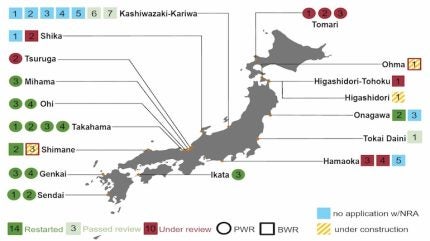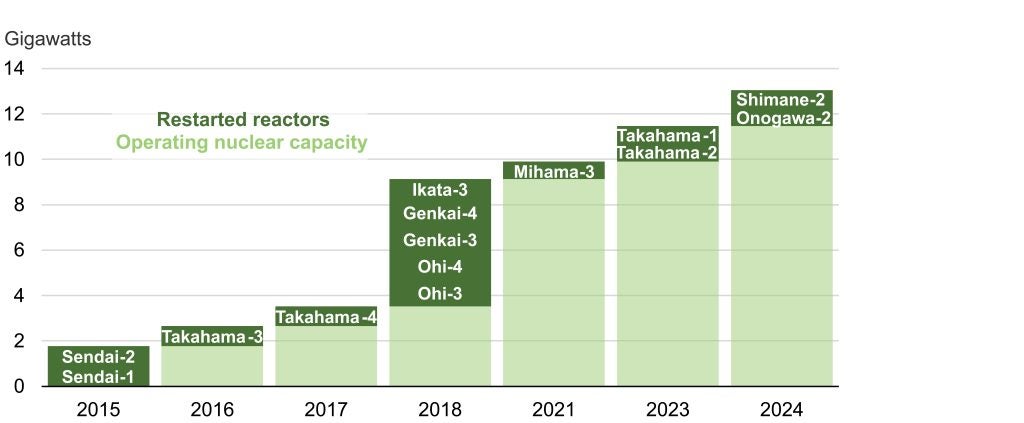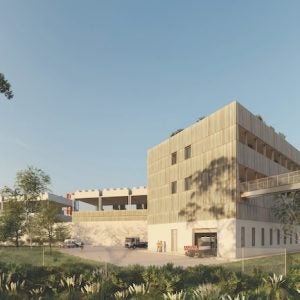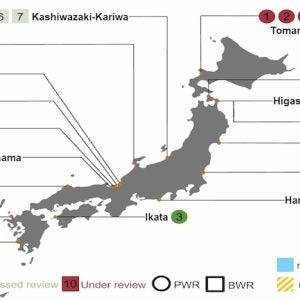
During 2024, Japanese utilities restarted two additional nuclear reactors that had been suspended from operations in response to the 2011 Fukushima Daiichi accident, taking the total number of restarted reactors to 14 since the accident. Tohoku Electric Power Co restarted its 796 MW Onagawa unit 2 reactor in November, and in December Chugoku Electric Power Co restarted Shimane unit 2 (789 MW). Onagawa is the nuclear power plant located closest to the epicentre of the March 2011 earthquake and tsunami.
Most of the restarted reactors have been PWRs located in western Japan. Onagawa unit 2 and Shimane unit 2 are the first BWRs to be restarted. Onagawa unit 2 is also the first reactor in the eastern part of the country to be restarted. Japan’s nuclear regulator prioritised the restart of PWRs due to public safety concerns regarding BWR technology, as employed in the destroyed Fukushima Daiichi units.
Japan suspended operation of its nuclear fleet from 2013 to 2015 for mandatory safety checks and upgrades following the 2011 Fukushima Daiichi accident. Before the accident, 54 commercial nuclear reactors were operating in Japan, and nuclear power accounted for approximately 30% of the country’s electricity generation. Nuclear restarts have proceeded slowly since the first two units (Sendai units 1 and 2) were restarted in 2015. Restarts have been slow due to a significantly more stringent safety inspection and authorisation process established after the accident and local court injunctions emerging from ongoing public safety concerns in some regions. Public support for restarts has been growing in Japan recently, however.

Under the current restart process, once regulatory approvals have been granted, the local municipality and prefectural governments are consulted prior to restart. In addition to the 14 reactors already restarted, three more units (namely, Kashiwazaki-Kariwa unit 6 and unit 7 and Tokai Daini) have received regulatory approval to restart but have yet to do so. Tohoku Electric Power announced in 2018 that Onagawa unit 1 would be decommissioned rather than upgraded, but the utility plans to seek approval to restart Onagawa unit 3. Restart of another ten units is under regulatory review.
The suspension of Japan’s nuclear fleet after the Fukushima accident significantly increased dependence on natural gas, oil, and coal imports to make up for lost domestic nuclear generation. It also led to a significant increase in PV installed in the country. Japan has limited domestic fossil fuel resources and imports virtually all the fossil fuels it uses. Consequently, Japan is the world’s second largest importer of LNG after China and the third largest importer of coal.
As part of Japan’s sixth long-term energy plan, last updated in October 2021, the central government called for the nuclear share of the country’s electricity generation to reach 20%–22% by 2030. Nuclear power accounted for about 6% of Japan’s electricity generation in 2023. A draft of Japan’s seventh long-term energy plan was released on 17 December 2024, and suggests nuclear power should account for 20% of Japan’s electricity supply
in 2040.
Japan’s current policy is to maximise the use of existing reactors by restarting as many units as possible and extending the licensed operating life beyond the current 60 year limit. The country also plans to develop next-generation reactors in co-operation with the domestic manufacturing industry and electric utilities.






